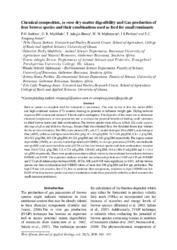| dc.contributor.author | Sarkwa, F.O. | |
| dc.contributor.author | Madibela, O. R. | |
| dc.contributor.author | Adogla-Bessa, T. | |
| dc.contributor.author | Mphinyane, W. N. | |
| dc.contributor.author | Perkins, J.S. | |
| dc.contributor.author | Timpong-Jones, E.C. | |
| dc.date.accessioned | 2021-01-26T08:54:42Z | |
| dc.date.accessioned | 2021-03-15T09:02:58Z | |
| dc.date.available | 2021-01-26T08:54:42Z | |
| dc.date.available | 2021-03-15T09:02:58Z | |
| dc.date.issued | 2020 | |
| dc.identifier.citation | Sarkwa, F. O., Madibela, O. R., Adogla-Bessa, T., Mphinyane, W. N., Perkins, J. S., & Timpong-Jones, E. C. (2020). Chemical composition, in vitro dry matter digestibility and Gas production of four browse species and their combinations used as feed for small ruminants. West African Journal of Applied Ecology, 28(2), 106-117. | en_US |
| dc.identifier.issn | 0855-4307 | |
| dc.identifier.uri | https://www.ajol.info/index.php/wajae/article/view/202713 | |
| dc.identifier.uri | http://moodle.buan.ac.bw:80/handle/123456789/316 | |
| dc.description.abstract | Browse species as complete feed for ruminants is uncommon. This may be due to low dry matter (DM) and high condensed tannins (CT) contents limiting its potential to influence weight gain. Drying however improves DM content and reduces CT levels and its astringency. The objective of this study was to determine chemical composition, in vitro parameters and to evaluate the potential benefits of feeding small ruminants on dried browse leaves and their combinations. The browse species were Albizzia lebbek, Gliricidia sepium, Moringa oleifera and Millettia thoningii. Rumen fluid was obtained from two fistulated forest type wethers for the in vitro evaluation. The DM, crude protein (CP), ash, CT, neutral detergent fibre (NDF), acid detergent fibre (ADF), cellulose and lignin were 866-916 g/kg, 101-303 g/kg DM, 74.7-200 g/kg DM, 0.9-1.3 g/kg DM, 202-552 g/kg DM, 205-520 g/kg DM, 94-381 g/kg DM and 105-192 g/kg DM respectively. The organic matter digestibility (OMD), in vitro dry matter digestibility (IVDMD), in vitro gas production (IVGP), metabolisable energy (ME) and short chain fatty acids (SCFA) of the four browse species and their combinations recorded were 314.9-721.6 g/kg DM, 515.4-721 ml/g DM, 139-602 ml/g DM, 314.6-1406.9 ml/g DM and 3.1-14.4 ml/g DM respectively. There were positive associative effects shown by the combined browse leaves between IVDMD and IVGP. The regression analyses revealed that relationships between IVGP and CP and IVDMD and CT and all relationships between OMD, SCFA, ME and IVGP were significant (p<0.05). All the browse species and their combinations had IVDMD values of more than 500 g/kg DM and low gas production. The high CP and ash contents, low CTs, low to moderate fibre components, moderate to high IVDMD and low IVGP of the four browse species and their combinations make them potentially valuable as feed resources for small ruminant production. | en_US |
| dc.language.iso | en | en_US |
| dc.publisher | West African Journal of Applied Ecology | en_US |
| dc.relation.ispartofseries | West African Journal of Applied Ecology;Vol. 28 (2) 2020 | |
| dc.subject | Chemical composition | en_US |
| dc.subject | In vitro dry matter | en_US |
| dc.subject | Digestibility | en_US |
| dc.subject | Gas production | en_US |
| dc.subject | Browse species | en_US |
| dc.subject | Feed | en_US |
| dc.subject | Small ruminants | en_US |
| dc.title | Chemical composition, in vitro dry matter digestibility and Gas production of four browse species and their combinations used as feed for small ruminants | en_US |
| dc.type | Article | en_US |

